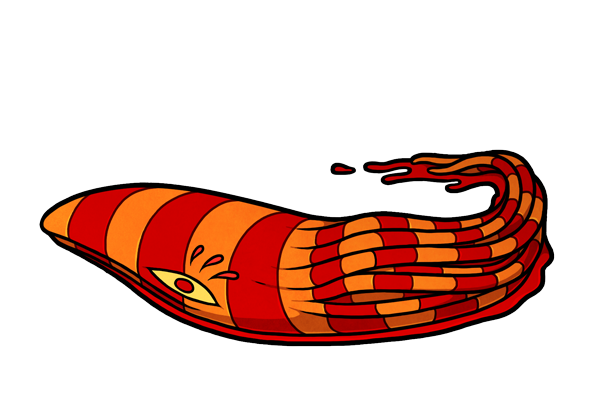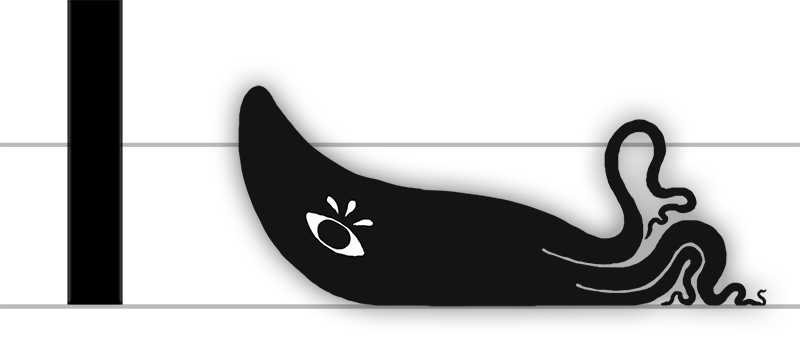

ymiridrine
the guillotines
prefix ymiri suffix drine
orhendrix solon
physical appearance
The ymiridrine /jəˈmɛɹɪdriːn/ is a red and stunted stranger that resembles a larger stranger's detached head. Its coloration varies regionally, as do the number and appearance of its teardrop markings (ranging from zero to six). Small, evenly-spaced yellow teeth line the stranger's black and tongueless mouth.Ꮆ The head ends in a set of tails, the number of which also varies (see criteria for healthy development, below).
Ꮆ Gummy – unnecessarily so, for what it needs to do.
The ymiridrine's thick surface is more rubbery than may be expected, and exudes blood from any point of contact, while its insides are filled with a viscous "pudding" that grows warm as it replenishes lost blood. As long as this "pudding" is healthy, at no point can the ymiridrine run dry. Its red blood sloshes both within, and leaves a trail as the stranger slithers forward.
The ymiridrine's blood is a melange of over a dozen creatures.ẖ
ẖ
1 mourning dove (Zenaida macroura)
2 Geoffroy's cat (Leopardus geoffroyi)
3 zebroid (E. "zebra" × E. "equine")
4 southern hagfish (Myxine australis)
5 Atlantic hagfish (Myxine glutinosa)
6 Indian giant squirrel (Ratufa indica)
7 human (Homo sapiens default)
8 Sonorated coral snake (Micruroides euryxanthus)
9 Annellan coral snake (Micrurus annellatus)
10 pterodactyl (Pterodactylus antiquus)
11 Sumatran tiger (Panthera tigris sondaica)
12 southern cassowary (Casuarius casuarius)
13 Blackstrap sea lion (Phocarctos hookeri novicolor)
When cut, slashed, struck, or otherwise harmed, the ymiridrine's blood bubbles up in an instant to fill the gap, and the flesh reforms within the clot. As such, the strain survives all but the most cataclysmic of injuries. Though it does not show cumulative scarring or any evidence of wounding, it does die after sufficient time or savagery.꒹
꒹
1 10-15 hard strikes with a bat or pipe
2 39,000 finger taps
3 103 inches worth of razor-blade lines
4 two gunshots (small gun)
5 one gunshot (shotgun)
6 100 gunshots (bb gun)
7 37 strikes with a heavy book
8 immolation in flames
9 constriction with garrote (3:23 minutes)
The hiss that emanates from the back of the ymiridrine's mouth is its only way of speaking.
a hiss that sounds wet, though no spit is produced.

environment and generation
The ymiridrine generates in environments which fulfill the following criteria: more than 70% of the wall must be tiled, the light must be tinted red (even if only slightly), a buzzing noise must be constantly present, and humidity must be above 24%. Locker or shower rooms, municipal maintenance areas, and pools are a few of the environs that thus spawn ymiridrine infestations. Furthermore, if a space which fulfills these criteria leads into or overlaps with another stranger's territory, the ymiridrine will generate with 100% frequency.
The strain always generates in groups, which emerge, solid sanguine in color and gummy in form, from a pool of blood upon the floor. These newborn ymiridrine coalesce and develop markings within three minutes, at which point they can be considered mature. The number of individuals that appear varies depending on the size of the room, with larger rooms spawning larger groups.
In territories that do not meet the strain's criteria for completely healthy development (see below), the ymiridrine is more frail, with darker colors. Its teeth appear beset with decay, and the limbs number only between 13 and 15. Stability is roughly 60-78% that of a healthy individual; otherwise, it displays no other deficiencies.
criteria for healthy development
Though the ymiridrine survives in many environments, it generates in its most ideal state only around at least 137 images of eyes. This criteria, though specific, is not impossible to fulfill; a single fashion magazine often exceeds this amount, with some graffiti or paper patterns being another enabler of physical fitness.
A healthy ymiridrine develops its full number of limbs (twenty in total), and displays a sharpness and a shimmer to its stained teeth.
behaviour and effects
Possessing an ill-formed and diminished nature, the ymiridrine does little but slide forward with its slug-like motions, red trail of blood behind it. A rudimentary strain, it exhibits only a temporary ability to learn from its experiences. Upon hitting a wall, for example, it pushes its nose forwards (weak and impotent) for two to ten seconds, until it turns its head and at last, adjusts its path. Nevertheless, within ten minutes, it always forgets everything it had "learned."
The ymiridrine will also react without reason. Biting at nothing, veering from invisible barriers, or sliding in circles, its activities quickly become stereotyped and repetitive.
The ymiridrine never leaves its territory, as its sole aversion is to the non-walled bounds of its space, though its paths still remain gently looping and turning. Individuals within a group avoid contact with one another, hissing when within three feet of each other. Skirmishes are not uncommon, however, with these encounters being marked by several minutes of rolling and biting, followed by mutual disinterest.
loss of stability
The same specific conditions that spawn the ymiridrine also confine its stability. Should there be a loss of any one of these conditions (a drop of humidity below 24%, for example), the ymiridrine can no longer survive, let alone thrive. Its flesh bubbles and becomes solid red in color, as its teeth rot, and its tendrils soften. If its conditions do not stabilize within ten minutes, it melts to bloody sludge. The only exception to this occurs when the ymiridrine's territory falls within another stranger's range; these "co-morbid" ymiridrine are able to survive for days (if not weeks) without the typical requirements for stability.
We're in the basement right now.
Someone drew eyes everywhere with red paint. But it's just those things again...
We're looking for the door right now.
We don't have the right key.
interactions with sensitives
The ymiridrine is initially ambivalent towards sensitives, and develops responsive behaviours only following physical contact. Half of ymiridrine become aggressive and attempt to bite at a sensitive with lackluster gnaws, play-wrestling like a puppy, but without the enthusiasm. A further 49.01% of individuals recoil and attempt to avoid further contact, but lose this evasive behaviour as do they lose all "memories". The remaining 0.09% of individuals display no evident response.
Regardless of behaviour, 99.99933% of encounters do not leave impact upon the sensitive.
Very rarely, however, (observed in only 0.00077% of encounters), the stranger provokes an effect which sets in slowly over the course of a week, peaking for twelve hours, before dropping off again by the end of three days. The highly disorientingᏗ sensation can be roughly compared to "phantom limb syndrome"...
...with these obstinate "phantom bodies" corresponding to the corporeal forms of the entireჵ living sensitive population.
This sensation is also felt by all other living sensitives, albeit in a less pronounced way. (With this peripheral effect lasting only minutes, indeed, many would be likely to describe it as a "full-body headache", were they one of the rare few to notice it at all.)
red-shifted blood frenzy
When exposed to blood that is not its own (or another ymiridrine's), the stranger grows ravenous. It won't stop attacking until it dies, squirming belly-up, driving its head into the tiles, and tearing at its surroundings and former companions.
This state also causes all nearby eyes and images of eyes to develop a bloody marking around them.
We keep having to kick them off...we killed three of them already.
"Killed".
We're coming back up to see you now.
After fifteen minutes to an hour in this state, the ymiridrine's stability drops, it throws up, its eyes bleed, and it collapses into crimson. The markings remain, drying out in time.
aging and death
The ymiridrine is a short-lived strain. As it ages, it slows down, and its blood flows less copiously. During its final hours, it becomes limp and stops moving altogether.
Groups of ymiridrine grow predatory towards any individual in the final thirty minutes of its lifespan. They swarm around their fallen companion, ripping them to shreds, and even slurping up the blood that flows out. They don't stop until every scrap is swallowed, sometimes choking on larger chunks in the process.
All the graffiti got ****ed up and my face is all wet.
This phone is getting really messed up.
Hey, we're at the front door.
Where are you?
above: final text messages from Sandra Lang to "Mz. Saqui".
The final ymiridrine within a territory musters up the last of its energy to devour itself, starting at the tail and working its way up. This end of this self-cannibalistic display resembles a tightly-coiled ball that at last crumples in on itself, and leaves behind only its drying trail of blood.




